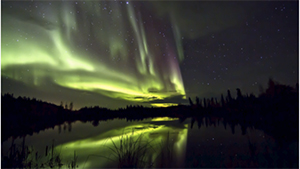
storms, photo courtesy of NOAA
A geomagnetic storm is a major disturbance of Earth's magnetosphere that occurs when there is a very efficient exchange of energy from the solar wind into the space environment surrounding Earth. The largest storms that result from these conditions are associated with solar coronal mass ejections (CMEs) where a billion tons or so of plasma from the sun, with its embedded magnetic field, arrives at Earth. CMEs typically take several days to arrive at Earth, but have been observed, for some of the most intense storms, to arrive in as short as 18 hours.
Storms also result in intense currents in the magnetosphere, changes in the radiation belts, and changes in the ionosphere, including heating the ionosphere and upper atmosphere region called the thermosphere. In space, a ring of westward current around Earth produces magnetic disturbances on the ground. A measure of this current, the disturbance storm time (Dst) index, has been used historically to characterize the size of a geomagnetic storm. In addition, there are currents produced in the magnetosphere that follow the magnetic field, called field-aligned currents, and these connect to intense currents in the auroral ionosphere. These auroral currents, called the auroral electrojets, also produce large magnetic disturbances. Together, all of these currents, and the magnetic deviations they produce on the ground, are used to generate a planetary disturbance index called Kp.
During storms, the currents in the ionosphere, as well as the energetic particles that precipitate into the ionosphere add energy in the form of heat that can increase the density and distribution of density in the upper atmosphere, causing extra drag on satellites in low-earth orbit. The local heating also creates strong horizontal variations in the in the ionospheric density that can modify the path of radio signals and create errors in the positioning information provided by GPS. While the storms create a beautiful aurora, they also can disrupt navigation systems such as the Global Navigation Satellite System (GNSS) and create harmful geomagnetic induced currents (GICs) in the power grid and pipelines. An increase in the geomagnetic disturbance index called Kp is observed. This index is the basis for one of the three NOAA Space Weather Scales, the Geomagnetic Storm, or G-Scale, that is used to describe space weather that can disrupt systems on Earth.
G-5 Extreme (Kp=9) These storms occur approximately 4 days over an 11 year cycle.
Expected Effects:
- Power systems: Widespread voltage control problems and protective system problems can occur, some grid systems may experience complete collapse or blackouts. Transformers may experience damage.
- Spacecraft operations: May experience surface charging and tracking problems, corrections may be needed for orientation problems.
- Other systems: Pipeline currents can reach hundreds of amps, HF (high frequency) radio propagation may be impossible in many areas for one to two days, satellite navigation may be degraded for days, low-frequency radio navigation can be out for hours, and aurora has been seen as low as Florida and southern Texas (typically 40º geomagnetic lat.).
G-4 Severe (Kp=8) These storms occur approximately 60 days over an 11 year cycle.
Expected Effects:
- Power systems: Possible widespread voltage control problems and some protective systems will mistakenly trip out key assets from the grid.
- Spacecraft operations: May experience extensive surface charging, problems with orientation, uplink/downlink and tracking satellites.
- Other systems: Induced pipeline currents affect preventive measures, HF radio propagation sporadic, satellite navigation degraded for hours, low-frequency radio navigation disrupted, and aurora has been seen as low as Alabama and northern California (typically 45º geomagnetic lat.).
G-3 Strong (Kp=7) These storms occur approximately 130 days over an 11 year cycle.
Expected Effects:
- Power systems: Voltage corrections may be required, false alarms triggered on some protection devices.
- Spacecraft operations: Surface charging may occur on satellite components, drag may increase on low-Earth-orbit satellites, and corrections may be needed for orientation problems.
- Other systems: Intermittent satellite navigation and low-frequency radio navigation problems may occur, HF radio may be intermittent, and aurora has been seen as low as Illinois and Oregon (typically 50º geomagnetic lat.).
G-2 Moderate (Kp=6) These storms occur approximately 360 days over an 11 year cycle.
Expected Effects:
- Power systems: High-latitude power systems may experience voltage alarms, long-duration storms may cause transformer damage.
- Spacecraft operations: Corrective actions to orientation may be required by ground control; possible changes in drag affect orbit predictions.
- Other systems: HF radio propagation can fade at higher latitudes, and aurora has been seen as low as New York and Idaho (typically 55º geomagnetic lat.).
G-1 Minor (Kp=5) These storms occur approximately 900 days over an 11 year cycle.
Expected Effects:
- Power systems: Weak power grid fluctuations can occur.
- Spacecraft operations: Minor impact on satellite operations possible.
- Other systems: Migratory animals are affected at this and higher levels; aurora is commonly visible at high latitudes (northern Michigan and Maine).